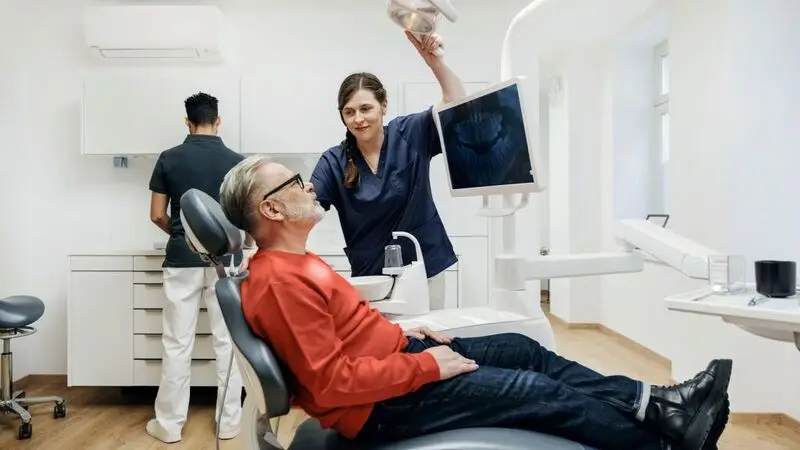
- An oral rinse to help detect stomach cancer is in the early stages of research.
- Gastric cancer is often not caught until it is in its late stages and treatment is limited.
- The success rate of the oral rinse still needs to be tested in more extensive studies.
An oral rinse could provide early detection of gastric cancer, according to a study that will be presented at Digestive Disease Week 2024.
This is early research that hasn’t been published yet in a peer-reviewed journal and this “swish and spit” rinse is not yet available.
In their study, researchers analyzed bacterial samples from 98 people – 30 with known gastric cancer, 30 with premalignant gastric conditions, and 38 people without gastric health issues.
The researchers reported there was little difference in the
The scientists said their findings suggest that the changes in the microbiome could occur as soon as the stomach environment starts to undergo changes that will eventually develop into cancer.
They added that the research indicates that oral bacteria could be a biomarker for gastric cancer risk.
The researchers plan to conduct more extensive studies to ensure the findings are generalizable to a broader population.
“This is a very intriguing and important study since we have no known sensitive methods, other than endoscopy, to detect gastric cancer or pre-gastric cancer lesions,” said Dr. Anton Bilchik, a surgical oncologist as well as the chief of medicine and the director of the Gastrointestinal and Hepatobiliary Program at Providence Saint John’s Cancer Institute in California. “A mouth rinse also sounds simple and easy to perform compared with an invasive procedure.”
“The microbiome (trillions of bacteria) in our body plays an important role in our immune system and the prevention of cancer, but there are clearly some bacteria that predispose us to cancer,” Bilchik, who wasn’t involved in the study, told Medical News Today. “A better understanding of these bacteria and the ability to detect them using a non-invasive technique potentially allows screening of large populations, particularly those at risk for developing gastric cancer.”
Dr. Elliot Newman, the chief of surgical oncology at Northwell Lenox Hill Hospital in New York, agrees that the researach is promising, but he cautions that more extensive studies are needed.
“It looks like the researchers used the samples to see each group’s shared characteristics,” Newman, who wasn’t involved in the study, told Medical News Today. “They could then compare other samples to see where they were —Healthy, precancerous, or cancerous.”
“Work like this is always exciting, but we have to see what happens in the long term,” he added. “In theory, someone could have the rinse and it can pick up changes in the stomach that might be precancerous. If we can do that, we can cure everyone.”
Gastric cancer, also known as stomach cancer, starts in the cells lining the stomach, according to the
There are several different types of stomach cancer, but the most common is adenocarcinoma. When it begins at the top of the stomach, it is called gastric cardia cancer. When it starts in other sections, it is called non-cardia gastric cancer.
Typically, stomach cancer isn’t detected until the tumor has grown to a large size or the cancer has metastasized outside the stomach, according to the
Although many people do not have signs of stomach cancer before diagnosis, if they do, they may experience:
- Poor appetite
- Unexplained weight loss
- Abdominal pain
- Vague discomfort in the abdomen, usually above the navel
- Feeling full after eating only a small meal
- Heartburn or indigestion
- Nausea
- Vomiting, with or without blood
- Swelling or fluid build-up in the abdomen
- Blood in the stool
- Anemia
- Jaundice if the cancer spreads to the liver
When the cancer is detected and treated while it remains in the stomach, the five-year survival rate is 75%, according to the
If detection and treatment do not start until after the cancer has spread outside the stomach, the five-year survival rate drops to 35%.
When the cancer metastasizes to distant areas of the body, the five-year survival rate plummets to 7%.
Stomach cancer treatment includes:
- Chemotherapy
- Radiation
- Immunotherapy
- Targeted drug therapy
- Surgery
- Hyperthermic Intraperitoneal chemotherapy
Treatment for stomach cancer often includes two or more types of treatment.
When choosing the best treatment, experts say a person and their medical team should pay attention to the location, stage, age, overall health, and personal preferences.
“Cancer takes years to develop,” said Newman. “Colon cancer takes seven to ten years. Stomach cancer is a little less, but it is still years. The researchers suggest that this oral rinse can pick up changes in the precancerous stage.”
“Gastric cancer often presents itself at a later stage when it is untreatable, so if we can detect it early, that is better,” he added. “But if we can detect it in the earliest stage, that is even better.”





